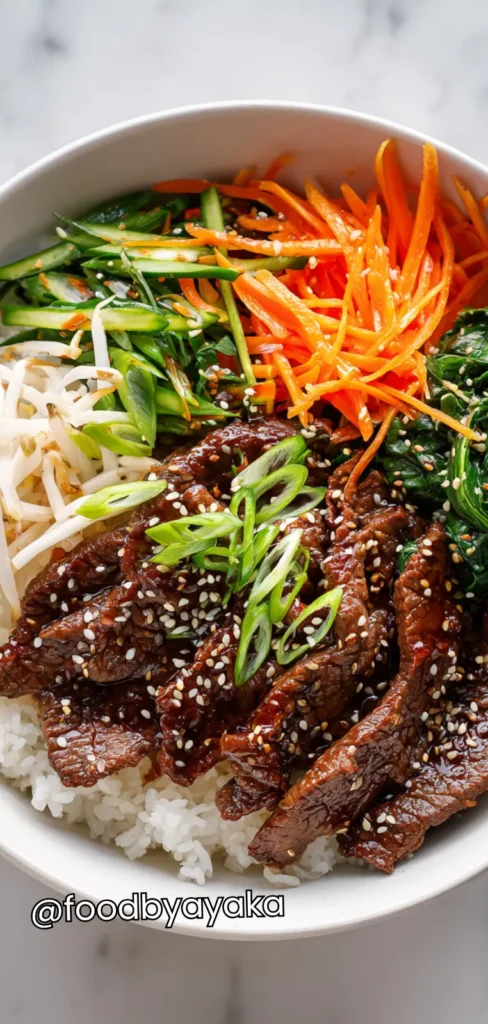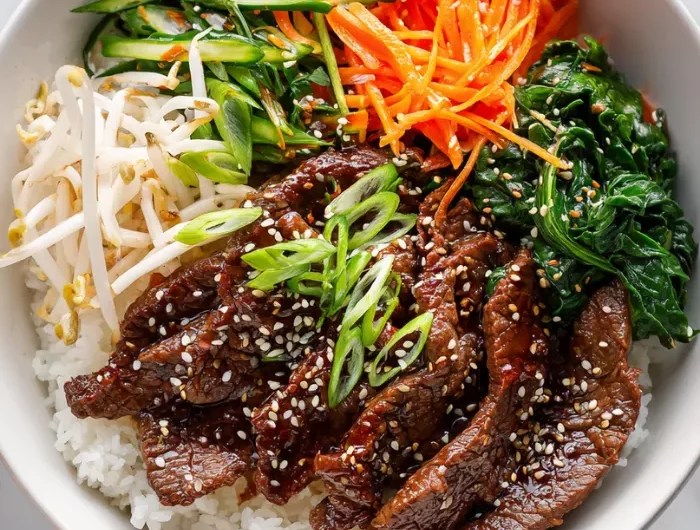Quick & Easy Recipes for Everyday Cooks
Welcome to Food By Ayaka!
Korean Beef Bulgogi Rice Bowl Recipe
My husband wasn’t a huge fan of sweet-savory meat dishes at first, but this bulgogi recipe changed his mind. The balance of flavors is irresistible—the beef turns out tender, glossy, and bursting with umami. The aroma of garlic and sesame fills our kitchen and feels like something from a cozy Korean restaurant. If you’re looking for a comforting and flavorful meal that comes together easily, this Korean Beef Bulgogi Rice Bowl might just become one of your favorites. It combines thinly sliced beef marinated in a sweet-savory sauce made of soy sauce, garlic, sesame oil, and a hint of sugar—then cooked to perfection and served over warm rice. The result is juicy, caramelized beef that’s slightly smoky and packed with flavor.
I have made this dish countless times for both family and friends. I use thinly sliced sirloin or ribeye for the best texture because they soak up the marinade perfectly. Always marinate your beef for at least 30 minutes, but if you have time, leave it overnight for a richer taste.

You can serve this bulgogi rice bowl with a fried egg on top, some spicy kimchi, and also with a few light sides like sautéed spinach or fresh cucumber salad for a full Korean-inspired meal.
It’s Perfect For:
- Busy weeknights
- Meal prep or packed lunches
- Family gatherings
- Cozy weekend dinners
- Comfort food cravings
Ingredients
- 1 lb thinly sliced beef ribeye or sirloin
- 1/4 cup soy sauce
- 2 tablespoons brown sugar
- 1 tablespoon honey
- 1 tablespoon sesame oil
- 3 cloves garlic, minced
- 1 small onion, finely grated
- 1 tablespoon rice wine (mirin) or water
- 1/2 teaspoon black pepper
- 1 teaspoon fresh ginger, grated
- 1 tablespoon sesame seeds
- 2 green onions, chopped
- 2 cups cooked white rice (for serving)
- Optional toppings: fried egg, kimchi, cucumber slices, or steamed veggies
Kitchen Equipment You’ll Need
- Mixing bowls
- Sharp knife and cutting board
- Skillet or grill pan
- Measuring spoons and cups
- Tongs or spatula
- Serving bowls
- Small saucepan (if making extra glaze)
How to Make Korean Beef Bulgogi Rice Bowl
Step 1
Prepare the Marinade: In a mixing bowl, combine soy sauce, brown sugar, honey, sesame oil, minced garlic, grated onion, rice wine, black pepper, and ginger. Whisk until the sugar fully dissolves and the mixture turns glossy. The balance of sweet, savory, and aromatic flavors is key here—smell it to make sure it’s fragrant before adding the beef.
Step 2
Marinate the Beef: Place the thinly sliced beef in a large bowl or ziplock bag. Pour the marinade over the beef and mix thoroughly using your hands or tongs to ensure every slice is evenly coated. Cover and refrigerate for at least 30 minutes, though marinating for 2–4 hours allows the flavors to fully develop.
Step 3
Cook the Bulgogi: Heat a large skillet or grill pan over medium-high heat. Once hot, add the marinated beef in batches (avoid overcrowding). Cook for 2–3 minutes per side, stirring often until the beef is browned, caramelized, and slightly crisp at the edges. If there’s extra marinade left in the bowl, pour a little over the meat as it cooks to intensify the flavor.
Step 4
Make the Rice Bowl: Scoop warm cooked rice into individual bowls. Top each serving with a generous portion of the sizzling bulgogi. Sprinkle sesame seeds and chopped green onions on top.
Step 5
Optional Add-Ons: For a complete Korean meal, top your bowl with a fried egg, a few slices of kimchi, or lightly steamed vegetables like spinach or carrots. These toppings add color, texture, and balance to the savory-sweet beef.
Tips for the Perfect Bulgogi
- Slice beef thinly: Freeze the beef slightly before slicing—it makes it easier to get those thin, even slices that cook fast and tender.
- Marinate long enough: Give it at least 30 minutes to rest, but 2 to 4 hours is even better for deep flavor infusion.
- Use high heat: Cooking the beef quickly over high heat ensures that it caramelizes beautifully without drying out.
- Don’t overcrowd the pan: Work in small batches to allow the beef to brown instead of steaming.
- Sweeten naturally: Try grated Asian pear or apple instead of sugar for a more authentic sweetness and tender texture.
- Save some marinade: Before adding beef, set aside a few tablespoons of marinade to drizzle over the rice later for extra flavor.
- Garnish for freshness: Top with green onions and sesame seeds—these small touches elevate the presentation and taste.
Optional Ingredients
- Gochujang (Korean chili paste) for spice
- Sliced mushrooms for more umami
- Carrot ribbons for color and crunch
- A splash of pear or apple juice for natural sweetness
- Bean sprouts for extra texture
- Nori flakes (seaweed) for garnish

How to Serve Korean Beef Bulgogi Rice Bowl
I love serving this dish hot, right out of the pan, over a bed of freshly cooked white rice. The warmth of the rice soaks up the juices from the beef, creating a satisfying blend of flavors in every bite. I drizzle a bit of the leftover sauce over the rice before topping it with bulgogi—this tiny step makes the rice incredibly flavorful and aromatic.
I usually prepare a few side dishes to accompany it, like kimchi, pickled radish, or sautéed spinach. The freshness and acidity of these sides balance the richness of the meat beautifully. If I’m serving guests, I also like to add a sunny-side-up egg on top, letting the yolk melt into the rice for extra creaminess.
When I serve this dish for a cozy dinner at home, I keep it simple but inviting. I sprinkle toasted sesame seeds and chopped green onions over the top, drizzle a little sesame oil for shine, and pair it with a bowl of miso soup or green tea. The presentation is effortless but feels comforting, warm, and homemade—exactly the kind of meal that makes everyone happy.
Is Korean Beef Bulgogi Rice Bowl Healthy?
Yes, it can be a balanced and wholesome meal. The beef provides a great source of protein and iron, while garlic, onions, and sesame oil add heart-healthy nutrients. If you pair it with brown rice or serve it with plenty of vegetables, it becomes a complete and nutritious dish.
However, because the marinade includes sugar and soy sauce, it’s best enjoyed in moderation if you’re watching your sodium or sugar intake. You can always make small adjustments—like using low-sodium soy sauce or reducing sugar—for a lighter version without losing flavor.
Variations and Substitutions
- Chicken Bulgogi: Use boneless chicken thighs instead of beef. They absorb the marinade beautifully and stay juicy.
- Pork Bulgogi (Dwaeji Bulgogi): Try thinly sliced pork shoulder with added gochujang for a spicy and smoky flavor twist.
- Vegetarian Bulgogi: Use tofu or mushrooms as the main protein. They soak up the marinade and taste surprisingly hearty.
- Bulgogi Lettuce Wraps: Skip the rice and wrap the beef in lettuce leaves with a bit of rice and chili paste for a lighter meal.
- Bulgogi Fried Rice: Use leftover bulgogi to make fried rice with vegetables and egg for a quick next-day meal.
- Bulgogi Noodle Bowl: Serve the beef over glass noodles or ramen for a fun variation with a chewy texture.
- Low-Sodium Version: Use low-sodium soy sauce, cut down the sugar, and add more grated onion for natural sweetness.
- Bulgogi Bibimbap: Serve with assorted veggies and a fried egg for a colorful rice bowl that feels like a full Korean feast.
How to Store and Reheat
To store, let the beef cool completely before placing it in an airtight container. Refrigerate for up to 4 days. Keep the rice separate to prevent it from getting soggy. You can also freeze marinated, uncooked beef for up to 2 months—it’s a great way to have a ready-to-cook meal on busy days.
To reheat, warm the beef in a pan over low heat with a splash of water or soy sauce to bring back its moisture. If reheating in the microwave, cover it loosely and heat for 1–2 minutes. For rice, sprinkle a little water and microwave or steam until soft and fluffy again.
Frequently Asked Questions About Korean Beef Bulgogi Rice Bowl
Can I use ground beef instead of sliced beef?
Yes, ground beef works wonderfully for a quick version. Cook it in a skillet until browned, then pour in the sauce and simmer until thickened.
Can I make this dish ahead of time?
Absolutely! You can marinate the beef a day in advance or even cook it early. Store in the fridge and reheat right before serving—it tastes even better the next day.
What kind of rice goes best with bulgogi?
Short-grain white rice is traditional, but jasmine or brown rice also works well. The mild flavor balances the bold sauce.
Can I make it without soy sauce?
You can substitute with coconut aminos or tamari for a gluten-free option that still gives a rich, salty flavor.
Korean Beef Bulgogi Rice Bowl Recipe
Course: Main DishCuisine: KoreanDifficulty: Easy4
servings20
minutes15
minutesEnjoy the rich, sweet, and savory flavors of this Korean Beef Bulgogi Rice Bowl recipe—thinly sliced marinated beef served over fluffy rice with sesame seeds and green onions. A quick, flavorful, and comforting Korean dish perfect for busy weeknights or cozy family dinners.
Ingredients
1 lb thinly sliced beef ribeye or sirloin
1/4 cup soy sauce
2 tablespoons brown sugar
1 tablespoon honey
1 tablespoon sesame oil
3 cloves garlic, minced
1 small onion, finely grated
1 tablespoon rice wine (mirin) or water
1/2 teaspoon black pepper
1 teaspoon fresh ginger, grated
1 tablespoon sesame seeds
2 green onions, chopped
2 cups cooked white rice (for serving)
Optional toppings: fried egg, kimchi, cucumber slices, or steamed veggies
Directions
- Prepare the Marinade: In a mixing bowl, combine soy sauce, brown sugar, honey, sesame oil, minced garlic, grated onion, rice wine, black pepper, and ginger. Whisk until the sugar fully dissolves and the mixture turns glossy. The balance of sweet, savory, and aromatic flavors is key here—smell it to make sure it’s fragrant before adding the beef.
- Marinate the Beef: Place the thinly sliced beef in a large bowl or ziplock bag. Pour the marinade over the beef and mix thoroughly using your hands or tongs to ensure every slice is evenly coated. Cover and refrigerate for at least 30 minutes, though marinating for 2–4 hours allows the flavors to fully develop.
- Cook the Bulgogi: Heat a large skillet or grill pan over medium-high heat. Once hot, add the marinated beef in batches (avoid overcrowding). Cook for 2–3 minutes per side, stirring often until the beef is browned, caramelized, and slightly crisp at the edges. If there’s extra marinade left in the bowl, pour a little over the meat as it cooks to intensify the flavor.
- Make the Rice Bowl: Scoop warm cooked rice into individual bowls. Top each serving with a generous portion of the sizzling bulgogi. Sprinkle sesame seeds and chopped green onions on top.
- Optional Add-Ons: For a complete Korean meal, top your bowl with a fried egg, a few slices of kimchi, or lightly steamed vegetables like spinach or carrots. These toppings add color, texture, and balance to the savory-sweet beef.

